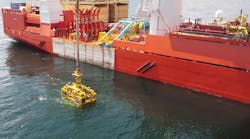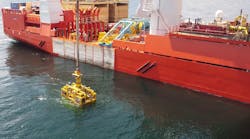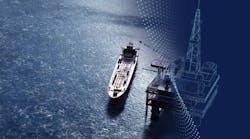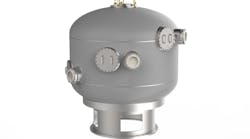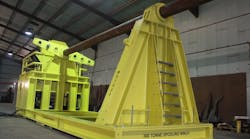Editor's note: This story first appeared in the May-June 2023 issue of Offshore magazine as part of the Remote Inspections & Operations Special Report.
By Tim Bingham, C-Innovation
The offshore oil and gas survey and inspection business has for the last few years been experiencing a shift to a greener, safer and more efficient way of performing its work. Many oil and gas majors are now increasingly moving towards options that enable them to reduce vessel days and therefore their carbon footprint, as well as eliminating risks to personnel.
C-Innovation (C-I), owner and operator of Schilling Robotics ROV systems, provides a range of specialized remote diagnostic and mission-planning software as well as augmented reality and mid-water StationKeep systems. Its inspection class, heavy-duty 150-HP and ultra-heavy-duty 200-HP ROVs are used to conduct a wide range of inspection type work.
In addition to being equipped with HD video, C-I’s ROVs integrate tooling due to their modular system and device configuration software. Examples of tooling capabilities for inspection work include camera booms, 3D modeling, UT/CP monitoring systems, mux integration, lasers and subsea cleaning tools.
Offshore Guyana case study
C-I’s fully remote operations have been available since the company first entered the remote survey industry in April 2020 at the height of the COVID-19 pandemic.
C-I’s goal was to provide its client with offshore services while operating safely from the company’s headquarters in Mandeville, La. The team was challenged from the beginning with its first project being based out of Guyanese waters. Operating at such a distance challenged C-I, and ultimately, the company performed successfully over a span of two years.
During the 2020 Guyana project, C-I operated a fully remote survey spread in international waters with zero recordable downtime and was consistently ahead of schedule in the client's fleet, remotely providing GVI/SURF inspections, as-laid/left surveys, valve operations, flowline/umbilical surveys, mooring line surveys, BOEM surveys, buoy placement and recovery operations, and USBL calibration/validations.
The Guyanese project was the precursor that set up the company’s success near its home in the Gulf of Mexico.
Recent projects
C-I has performed several remote surveying operations over the past year. For example, in January 2022, C-I began remote operations on Juan C , including BOEM inspections, mooring line inspections, and USBL calibration/validations.
During summer 2022, C-I enabled simulation operations on the Island Venture vessel, and the company successfully enabled remote access to the platform to view the Island Venture ROVs.
Then, in August 2022, C-I began remote operations on the C-Constructor vessel, which included jumper ops, mooring line inspections, tree/well installations and USBL calibration/validation.
At year-end 2022, C-I began remote operation with GIS, and this included remote navigation for geophysical work in Mexican waters.
More recently, in February 2023, C-I began remote operations on Laney. The client required remote viewing at the base in Providence, Rhode Island. The company set up a live working system involving plough operations to be viewed remotely.
Surveying vessels
C-I has five vessels that are actively involved in remote survey operations, which increases safety and reduces greenhouse-gas emissions to the environment. Operating out of the company’s remote operations center (ROC) at C-I’s headquarters, its remote surveyor eliminates the risk for potential personal injury while onboard the vessel and cuts down on travel hazards to and from a vessel or heliport.
By placing an experienced remote surveyor on duty at the ROC with the ability to log in to any vessel in the fleet, troubleshooting any potential problems has become a much more manageable process. The remote surveyor can log in and comb through settings to ensure the correct items are enabled in response to any flagged issues with the system, which has significantly reduced survey downtime.




